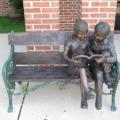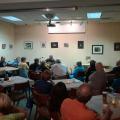The first settlers to Lacey were the Lenape Indians, who foraged along the bay for fish and shellfish. No white settlers arrived until the early eighteenth century. In the 1760s, the first house of worship, constructed by Thomas Potter, was established at Good Luck, and later became the birthplace of the Universalist Church of America. In 1809, John Lacey, a Revolutionary War general, built Ferrago Forge. For his contribution to the growth and importance of the area, the township was named for him when it was incorporated in 1871.
The beginning of the 19th century saw the decline of the lumber and bog ore industries, as resources were depleted. Fishing, oystering, and the pleasure resort trade became the major industries. Although less than 500 people lived in Lacey, the town had a number of large hotels: the Lafayette House, the Carman House (which later became Eno’s Riverside Hotel), the Blodgett House, and Parker House (which became the Greyhound Inn). All these hostelries are gone, except for the casino of Eno’s Hotel, which today is the Captain’s Inn. These hotels catered to tourists who came for boating, fishing, and hunting. Some local residents found jobs in these tourist-related occupations, but a number of employees were recruited elsewhere. Other areas of employment for residents centered around cutting ice on the Mill Pond, cutting salt hay in the meadows, farming, a bottling works, and boat building.
The township is still comprised of three areas: Forked River, Lanoka Harbor, and Bamber; but they no longer function as separate entities. Until the 1930s, each community had its own post office, school, school board, and railroad station isolated from each other by poor roads and distance. Bamber, located to the west of the Parkway, was served by the Tuckerton Railroad, while Forked River and Lanoka Harbor were serviced by the Central Railroad of New Jersey.
A group of Newark businessmen began the Barnegat Pines development, which subsequently brought new residents from central and north New Jersey, as well as Pennsylvania.
Lacey operates in the Township Form of government, one of the oldest forms in New Jersey. Laws governing the Township Form of government were last rewritten in 1989. Under the Township format, we have a five member Township Committee, where committee-people are elected in three year staggered terms. The Committee selects one of their own to be mayor for a one-year term.







